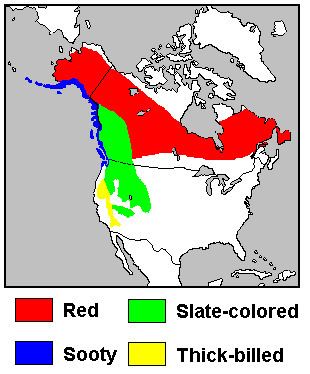The slate-colored fox sparrow (Passerella (iliaca) schistacea) group comprises the Rocky Mountain taxa in the genus Passerella. It is currently classified as a "subspecies group" within the fox sparrows pending widespread acceptance of species status.
It has long been suspected to be a separate evolutionary lineage due to morphological distinctness (Swarth 1920). More recently, it has been split into the present clade and the thick-billed fox sparrow. These are morphologically quite similar, but can be readily distinguished according to mtDNA sequence and haplotype data. (Zink 1994) However, these results were considered tentative (Rising & Beadle 1996) until more molecular data and apparent lack of wide-ranging hybridization coupled with ecological differences and adaptations led to confirmation of their distinctiveness (Zink & Kessen 1999); this group appears to be most closely related to the red fox sparrows (Zink & Weckstein 2003 contra Zink 1996), judging from biogeography.
It is found to breed in mountainous regions from the interior of northwest British Columbia to Nevada and eastern California (Rising & Beadle 1996). It is a tiny-billed bird with a gray head and mantle, brown wings, brown breast streaks, and a russet tail.
Like all "fox sparrow" subspecies, it is differentiated into some morphologically recognizable allopatric populations, which are still genetically indistinguishable due to their recent evolution (Zink 1994).
However, the handful or so subspecies in this complex are poorly differentiated even morphologically for the most part; a two-subspecies arrangement recognizing the rather distinctive altivagans (the northern form) as distinct from the southern populations (schistacea) might be more reasonable (Rising & Beadle 1996). As with red and sooty fox sparrows, slate-coloreds also prefer to build their nests on the edges of wet habitat but are much less picky about in which plant they build. Their call note is sharp klink according to Rising & Beadle (1996), or "a sharp smack, like Sooty and Red populations" according to Sibley (2000).
schistacea Baird, 1858:Breeds from
Crowsnest Pass (British Columbia) and Waterton Lakes Park (southwest
Alberta) south through the
Great Basin mountain ranges. Patchily distributed to wards the southern end of its range, it ranges as far as northern Nevada (
Humboldt County, Elko County), Fort Bridger,
Wyoming, and Cochetopa Creek (western
Colorado). Moves coastwards in winter, occurring mainly in southern California.(Weckstein
et al. 2002)The nominate subspecies of the group, its head and back are slate gray, with a brown wash on the back. Wings, rump, tail, crown and underside spotting are a rich darkish brown, somewhat more rusty on the tail (Rising & Beadle 1996).
altivagans Riley, 1911:Breeds inland from central British Columbia to the area of Crowsnest Pass. In winter, mainly in the
Cascade Range and Sierra Nevada, California, and coastal areas to the southwest of this south to northernmost
Mexico. (Weckstein
et al. 2002)Overall similar to
schistacea, but back noticeably brown and wings and tail with pronounced rusty wash. Altogether, intermediate between
schistacea and the eastern fox sparrow (
P. (iliaca) iliaca) in morphology, but well distinguished from latter by vocal and molecular characters (Rising & Beadle 1996). Considerable variation in this population suggests some hybridization with the
sooty fox sparrow subspecies
fuliginosa and the Yukon fox sparrow, as well as
intergradation with
schistacea (around
Banff) and the doubtfully distinct
olivacea (Weckstein
et al. 2002).
canescens Swarth, 1918:Breeds in mountain ranges in central Nevada, notably the
Shoshone Mountains, and the
Toiyabe, and
Monitor Ranges, and the
White Mountains, California. Winters in the California-Arizona-Mexico border area.(Weckstein
et al. 2002)Similar to
schistacea sensu stricto and doubtfully distinct from it; somewhat grayer overall (Rising & Beadle 1996).
olivacea Aldrich, 1943:Breeds from the
Nelson area (British Columbia) south along the eastern slopes of the Cascade Range probably to northern
Idaho and northwestern
Montana, reaching east as far as the Blue Mountains of
Oregon. In winter, migrates to California (Tehama County,
Piute Mountains) and the
Sierra Juárez in northern Mexico.(Weckstein
et al. 2002)Doubtfully distinct from
schistacea sensu stricto (Rising & Beadle 1996). Intermediate between this form and the
fulva thick-billed fox sparrows ; darker and browner than the first, and brown olive- rather than red-tinged; bill small as in
schistacea with which it intergrades. (Weckstein
et al. 2002)
swarthi Behle & Selander, 1951:Breeds from Bannock County and Bear Lake County, Idaho, through mountain ranges in
Utah south to Sanpete County. Winter range unknown. (Weckstein
et al. 2002)A very gray form with heavy breast pattern, but as it apparently intergrades with
schistacea and
canescens (Weckstein
et al. 2002) doubtfully distinct from the former (Rising & Beadle 1996).

